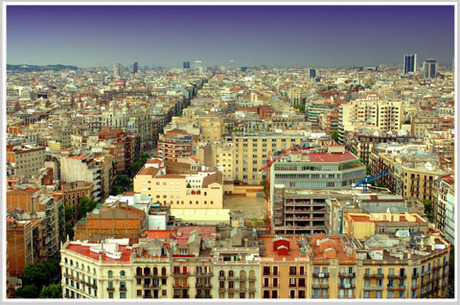Eixample
The Eixample is a district of Barcelona between the old city (Ciutat Vella) and what were once surrounding small towns (Sants, Gràcia, Sant Andreu etc.), constructed in the 19th and early 20th centuries. Eixample attracts the tourist with its fabulous sights and with unique atmosphere.
The Eixample is characterized by long straight streets, a strict grid pattern crossed by wide avenues, and square blocks with chamfered corners (named illes in Catalan, manzanas in Spanish). This was a visionary, pioneering design by Ildefons Cerdà, who considered traffic and transport along with sunlight and ventilation in coming up with his characteristic octagonal blocks, where the streets broaden at every intersection making for greater visibility, better ventilation and (today) some short-stay parking space. The grid pattern remains as a hallmark of Barcelona, but many of his other provisions were unfortunately ignored: the four sides of the blocks and the inner space were built instead of the planned two or three sides around a garden; the streets were narrower; only one of the two diagonal avenues was carried out; the inhabitants were of a higher class than the mixed composition dreamed of by Cerdà. The important needs of the inhabitants were incorporated into his plan, which called for markets, schools, hospitals every so many blocks. Today, most of the markets remain open in the spots they have been from the beginning.
Some parts of the Eixample were influenced by Modernista architects, chief among whom was Antoni Gaudí. His work in the Eixample includes the Casa Milà (nicknamed La Pedrera) and the Casa Batlló, both of which are on the wide Passeig de Gràcia, as well as the Sagrada Família. Other architects who made highly significant, and certainly more numerous, contributions to giving the Eixample its characteristic appearance include Josep Puig i Cadafalch, Josep Domènech i Estapà, Josep Vilaseca i Casanovas and perhaps above all Enric Sagnier i Villavecchia, responsible for a total of over 500 buildings in the city (not all of them in the Eixample).
The Casa Terrades, better known as Casa de les Punxes, is a spectacular building replete with Mediaeval allusions that stands at the junction of Av. Diagonal with Carrer Rosselló. It was built in 1903-5 by the Modernista architect Josep Puig i Cadafalch, who used Nordic Gothic and Spanish Plateresque resources side by side, along with traditional Catalan motifs.
The Casa Batlló is part of a block called the Illa de la Discòrdia, along with two other notable Modernista works, Lluís Domènech i Montaner's Casa Lleó Morera and Josep Puig i Cadafalch's Casa Amatller. The block is so named due to the visual clash between the buildings; its Spanish name, Manzana de la Discordia, is also a pun on Eris's Apple of Discord - manzana means both "apple" and "city block".
The district is often divided for practical purposes in two: Esquerra de l'Eixample and Dreta de l'Eixample (left and right sides of Eixample, respectively). Traditionally and officially it is divided into five neighbourhoods. These are, in addition to the areas already mentioned, Sant Antoni, Sagrada Família and Fort Pienc, also known as Fort Pius. The latter has recently become notable for the number of Asian, chiefly Chinese residents and the proliferation of Asian shops.
Some parts of Eixample are rather well-to-do neighbourhoods, especially around the central areas such as Passeig de Gràcia, Rambla de Catalunya and the Avinguda Gaudi/Sagrada Familia vicinity, but it also contains many decaying buildings inhabited by lonely aged tenants on the verge of poverty, especially in the fringe areas. It also has a large proportion of immigrant population.
L'Eixample is the place where most of the city's mid-range and top-end hotels are located. This quarter is very well connected with the rest of the city, although if you go by car it's impossible to park in the street. Most of the apartments in the Eixample are within easy walking distance from Paseo de Gracia with its two wonderful modernist period buildings by Antoni Gaudi and other architects.
The Eixample is very well connected, and from here you can easily walk or take buses or taxis to the Gothic Quarter and Las Ramblas for attractions such as the Picasso museum and the Cathedral. There are endless restaurants and street cafes to relax in throughout the area, which is full of stunning modernist buildings adorned with intricate stone and iron facades. This is where the rich and famous have traditionally lived and it is still a popular upmarket residential and business area. The district is a great starting point for sightseeing in Barcelona. Easily accessible from the airport right after the flight to Barcelona and offering the eclectic tastes of Barcelona, Eixample rightfully founds place in every tourist guide in Barcelona. You can get there via direct flight to Barcelona or to Girona, Reus or Lleida – Alguaire.




